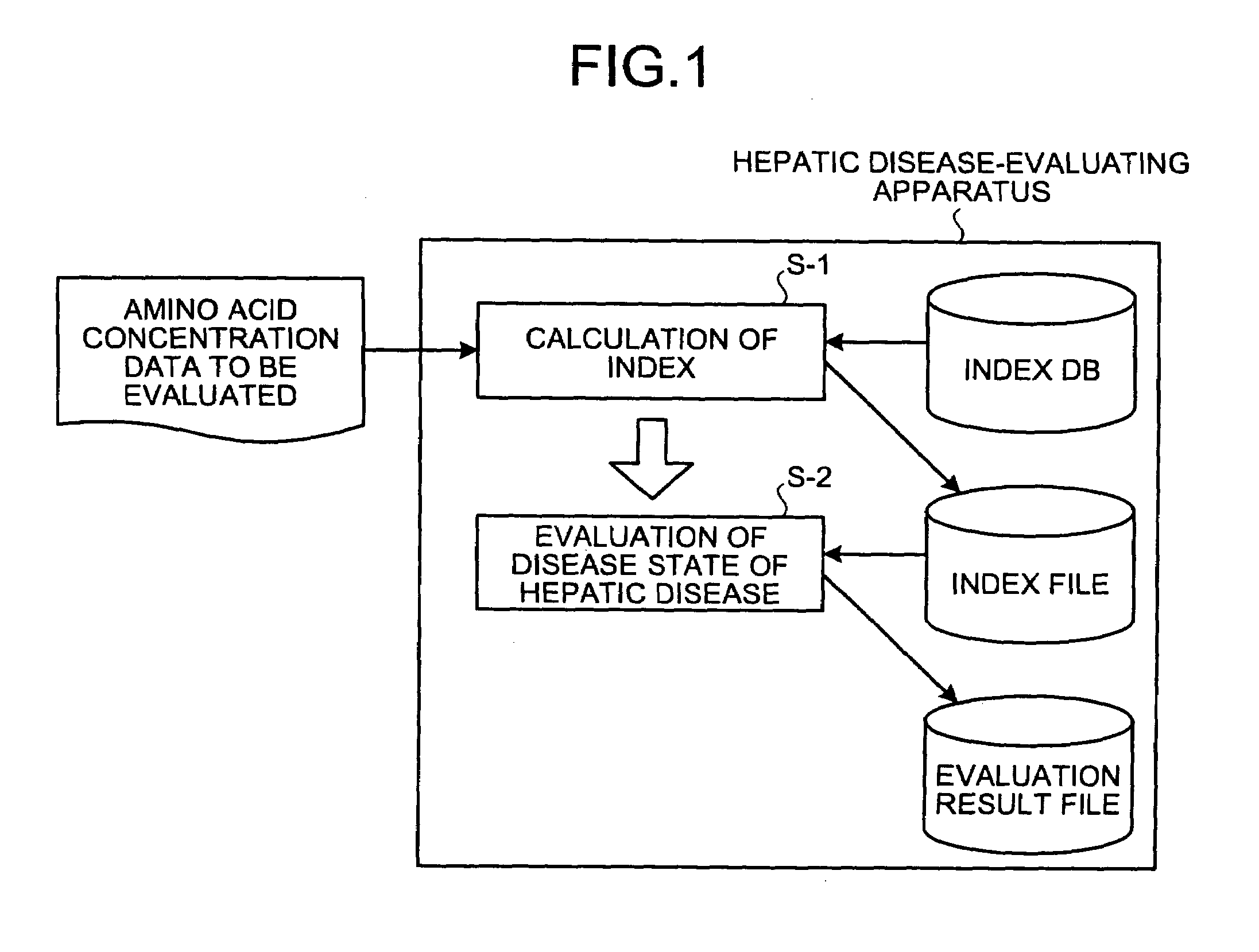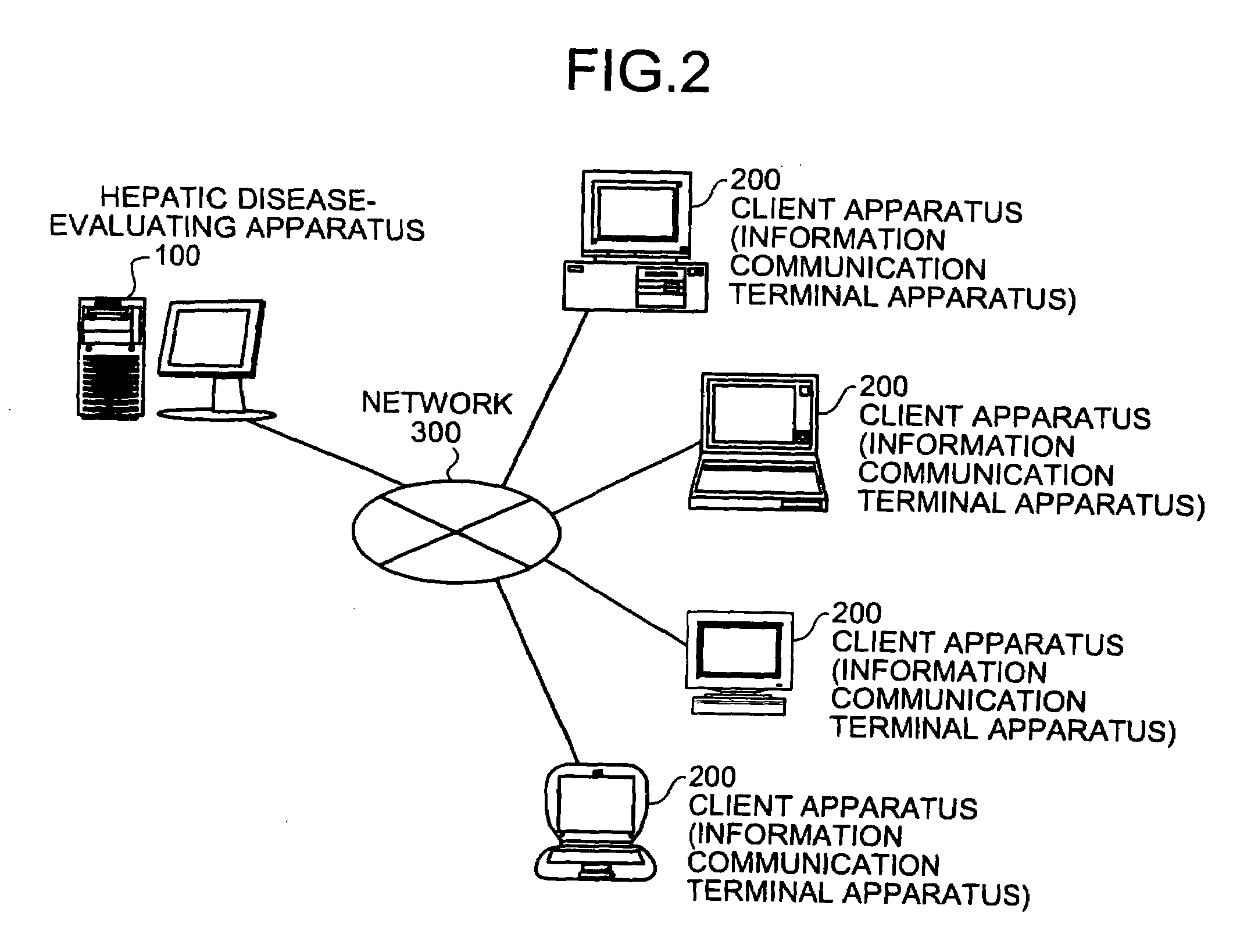Hepatic disease-evaluating apparatus, hepatic disease-evaluating method, hepatic disease-evaluating system, hepatic disease-evaluating program and recording medium
a technology of hepatic disease and evaluation method, which is applied in the direction of peptide/protein ingredients, peptide sources, instruments, etc., can solve the problems of not always being able to determine whether treatment is needed after testing, accompanied by risks, and giving patients physical and mental burdens
- Summary
- Abstract
- Description
- Claims
- Application Information
AI Technical Summary
Benefits of technology
Problems solved by technology
Method used
Image
Examples
example 1
[0130]In Example 1, diagnosis results obtained by hepatic biopsy and those obtained according to the index concerning whether the progressive stage of hepatic fibrosis of a patient with hepatitis C is in the stage of F0, F1, F2, or F3 or in the stage of F4 were compared. After intensive studies to maximize the efficiency of discriminating the two groups: “F0, F1, F2, or F3” and “F4” concerning the progressive stage of hepatic fibrosis, an index 1: “(Phe) / (Val)+(Thr+Met+Orn) / (Pro+Gly)” was obtained as such an index. The diagnostic performance of the index 1 for discrimination of the two groups: “F0, F1, F2, or F3” and “F4” was evaluated by using the AUC (Area Under Curve) of the ROC curve (Receiver Operating Characteristic Curve) shown in FIG. 14. In diagnosis according to the index 1, the blood amino acid concentration, as determined from the blood samples of hepatitis C patients diagnosed by hepatic biopsy by using the amino acid analysis method described in the embodiment above wa...
example 2
[0133]In Example 2, the diagnosis results obtained by hepatic biopsy and those obtained according to the index concerning whether the progressive stage of hepatic fibrosis of a patient with hepatitis C is in the stage of F0, F1, or F2 or in the stage of F3 or F4 were compared. After intensive studies to maximize the efficiency of discriminating the two groups: “F0, F1, or F2” and “F3 or F4” concerning the progressive stage of hepatic fibrosis, an index 1“(Phe) / (Val)+(Thr+Met+Orn) / (Pro+Gly)” was obtained as such an index, similarly to Example 1. The diagnostic performance of the index 1 for discrimination of the two groups “F0, F1, or F2” and “F3 or F4” was evaluated by using the AUC (Area Under Curve) of the ROC curve (Receiver Operating Characteristic Curve) shown in FIG. 15. In the diagnosis according to the index 1, the blood amino acid concentration used in Example 1 was used.
[0134]As a result, the AUC of index 1 was 0.92±0.04 (95% confidence interval: 0.84 to 1.00). On the othe...
example 3
[0136]In Example 3, the diagnosis results obtained by hepatic biopsy and those obtained according to the index concerning whether the progressive stage of hepatic fibrosis of a patient with hepatitis C is in the stage of F0, F1, F2, or F3 or in the stage of F4 were compared. After intensive studies to maximize the efficiency of discriminating the two groups: “F0, F1, F2, or F3” and “F4” concerning the progressive stage of hepatic fibrosis, the indices shown in FIGS. 17 to 20 were obtained as indices having a diagnostic performance (discrimination efficiency) similar to the index 1 in Example 1 or 2. The diagnostic performance of the indices shown in FIGS. 17 to 20 in discrimination of two groups “F0, F1, F2, or F3” and “F4” were evaluated by using the AUC of ROC curve. The blood amino acid concentration used in Example 1 or 2 was used in diagnosis according to the index.
[0137]As a result, in discrimination of two groups “F0, F1, F2, or F3” and “F4” by using the indices shown in FIGS...
PUM
| Property | Measurement | Unit |
|---|---|---|
| Fraction | aaaaa | aaaaa |
| Solar gamma radiation | aaaaa | aaaaa |
| Solar gamma radiation | aaaaa | aaaaa |
Abstract
Description
Claims
Application Information
 Login to View More
Login to View More - R&D
- Intellectual Property
- Life Sciences
- Materials
- Tech Scout
- Unparalleled Data Quality
- Higher Quality Content
- 60% Fewer Hallucinations
Browse by: Latest US Patents, China's latest patents, Technical Efficacy Thesaurus, Application Domain, Technology Topic, Popular Technical Reports.
© 2025 PatSnap. All rights reserved.Legal|Privacy policy|Modern Slavery Act Transparency Statement|Sitemap|About US| Contact US: help@patsnap.com



